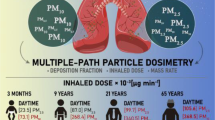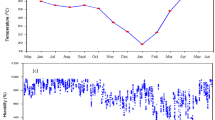Abstract
Absorbed dose rate in air for the Tehri Garhwal region of Uttarakhand state, India was measured using a vehicle-mounted NaI(Tl) scintillation spectrometer. The average values of absorbed dose rate in air for Jakhana and New Tehri areas in this region were 150 nGy h−1 and 88 nGy h−1, respectively, and the respective estimated average external effective doses for the areas were 1.06 mSv y−1 and 0.62 mSv y−1. Higher dose rates observed in the Jakhana area were possibly related to uraninite and sericite which were formed as a result of hydrothermal alteration and found in the area.





Similar content being viewed by others
References
United Nations Scientific Committee on the effects of atomic radiation (2000) UNSCEAR 2000 report to the General Assembly, with scientific annexes. Annex B exposures from natural radiation sources. United Nations, New York
Christa EP, Jojo PJ, Vaidyan VK, Anilkumar S, Eappen KP (2012) Radiation dose in the high background radiation area in Kerala, India. Radiat Protect Dosim 148:482–486
Inoue K, Sahoo SK, Veerasamy N, Kasahara S, Fukushi M (2020) Distribution patterns of gamma radiation dose rate in the high background radiation area of Odisha, India. J Radioanal Nucl Chem 324:1423–1434
Singh HN, Shanker D, Neelakandan VN, Singh VP (2007) Distribution patterns of natural radioactivity and delineation of anomalous radioactive zones using in situ radiation observations in Southern Tamil Nadu, India. J Hazard Mater 141:264–272
Gusain GS, Rautela BS, Sahoo SK, Ishikawa T, Prasad G, Omori Y, Sorimachi A, Tokonami S, Ramola RC (2012) Distribution of terrestrial gamma radiation dose rate in the eastern coastal area of Odisha, India. Radiat Protect Dosim 152:42–45
El-Khatib AM, El-Khier AAA (1988) Regional Study of Black Sands Radioactivity. Isotopenpraxis Isotopes Environ Health Stud 24:333–336
Wei L, Sugahara T (2000) An introductory overview of the epidemiological study on the population at the high background radiation areas in Yangjiang China. J Radiat Res 41(Suppl):1–7
Moura CL, Artur AC, Bonotto DM, Guedes S, Martinelli CD (2011) Natural radioactivity and radon exhalation rate in Brazilian igneous rocks. Appl Radiat Isotopes 69:1094–1099
Bajwa BS, Kumar S, Singh S, Sahoo SK, Tripathi RM (2017) Uranium and other heavy toxic elements distribution in the drinking water samples of SW-Punjab, India. J Radiat Res Appl Sci 10:13–19
Prasad M, Ranga V, Kumar GA, Ramola RC (2020) Radiological impact assessment of soil and groundwater of Himalayan regions in Uttarakhand, India. J Radioanal Nucl Chem 323:1269–1282
Adithya V, Sabarathinam C, Keesari T, Mohokar H, Prasanna MV (2019) Occurrence of uranium in groundwater along the lithological contacts in Central Tamilnadu, India: an isotope hydrogeochemical perspective. Expos Health 11:277–290
Prabhu RS, Sathyapriya R, Sahoo SK, Mohapatra S (2008) Ingestion dose due to natural uranium to the public through drinking water pathways in two districts of Kerala. In: Proceedings of 16th national symposium on environment, Hisar, Vol. 39, No. 36, pp. 551–555.
Rani A, Singh S, Duggal V, Balaram V (2013) Uranium estimation in drinking water samples from some areas of Punjab and Himachal Pradesh, India using ICP-MS. Radiat Protect Dosim 157:146–151
Veerasamy N, Murugan R, Kasar S, Inoue K, Kavasi N, Balakrishnan S, Arae H, Fukushi M, Sahoo SK (2021) Geochemical characterization of monazite sands based on rare earth elements, thorium and uranium from a natural high background radiation area in Tamil Nadu. India J Environ Radioact 232:106565
Sadasivan S, Shukla VK, Chinnaesakki S, Sartandel SJ (2003) Natural and fallout radioactivity measurement in Indian soils. J Radioanal Nucl Chem 256:603–607
Veerasamy N, Sahoo S, Inoue K, Fukushi M, Tsuruoka H, Arae H, Balakrishnan S (2019) Natual radioactivty measurement and dose assessment of beach placer sands in the coastal region of Tamil Nadu (India). Radiat Protect Dosim 184:409–412
Huy N, Hien P, Van Tran L, Hoang D, Hiep H, Nguyen Q, Long N, Nhan D, Binh N, Hai P, Ngo N (2012) Natural radioactivity and external dose assessment of surface soils in Vietnam. Radiat Protect Dosim 151:522–531
Inoue K, Tsuruoka H, Van Le T, Arai M, Saito K, Fukushi M (2016) Impact on ambient dose rate in metropolitan Tokyo from the Fukushima Daiichi Nuclear Power Plant accident. J Environ Radioact 158–159:1–8
Saito K, Inoue K, Ishita Y, Shimizu H, Fukushi M (2022) Distribution of gamma radiation dose rate and activity concentration in soil related with natural radionuclides on Taiwan main island. Radiat Protect Dosim 198:998–1003
Inoue K, Fukushi M, Van Le T, Tsuruoka H, Kasahara S, Nimelan V (2020) Distribution of gamma radiation dose rate related with natural radionuclides in all of Vietnam and radiological risk assessment of the built-up environment. Sci Rep 10:12428
Bineng GS, Saïdou HM, Tchuente Siaka YF, Akata N, Feutseu Talla S, Ele Abiama P, Tokonami S (2020) External Radiation Exposure to the Public Using Car-borne Survey Method in the Uranium and Thorium Bearing Region of Lolodorf, Cameroon. Radiat Environ Med 9:13–20
Inoue K, Hosoda M, Shiroma Y, Furukawa M, Fukushi M, Iwaoka K, Tokonami S (2015) Changes of ambient gamma-ray dose rate in Katsushika Ward, metropolitan Tokyo before and after the Fukushima Daiichi nuclear power plant accident. J Radioanal Nucl Chem 303:2159–2163
Hosoda M, Inoue K, Oka M, Omori Y, Iwaoka K, Tokonami S (2016) Environmental radiation monitoring and external dose estimation in aomori prefecture after the Fukushima Daiichi nuclear power plant accident. Jpn J Health Phys 51:41–50
Inoue K, Tsuruoka H, Le Van T, Fukushi M (2016) Contribution ratios of natural radionuclides to ambient dose rate in air after the Fukushima Daiichi Nuclear Power Plant accident. J Radioanal Nucl Chem 307:507–512
Tanigaki M, Okumura R, Takamiya K, Sato N, Yoshino H, Yamana H (2013) Development of a car-borne γ-ray survey system, KURAMA. Nucl Instrum Methods Phys Res A 726:162–168
Yadav M, Prasad M, Dutt S, Ramola RC (2022) Variation of natural radioactivity in soil and water samples of Garhwal Himalaya, India. J Radioanal Nucl Chem 331:1951–1958
Ramola R, Gusain G, Badoni M, Prasad Y, Prasad G, Ramachandran T (2008) 226Ra, 232Th and 40K contents in soil samples from Garhwal Himalaya, India, and its radiological implications. J Radiol Prot 28:379–385
Bhagchi D SR (2011) Ground water brochure, district Tehri Garhwal, Uttarakhand. Central Ground Water Board. http://cgwb.gov.in/District_Profile/Uttarakhand/Tehri%20Garhwal.pdf. Accessed 12 Aug 2023
Wessel P, Smith WHF (1991) Free software helps map and display data. EOS, Trans Am Geophys Union 72:441–446
Minato S (2001) Diagonal elements fitting technique to improve response matrixes for environmental gamma ray spectrum unfolding. Radioisotopes 50:463–471
Hosoda M, Tokonami S, Omori Y, Sahoo SK, Akiba S, Sorimachi A, Ishikawa T, Nair RR, Jayalekshmi PA, Sebastian P, Iwaoka K, Akata N, Kudo H (2015) Estimation of external dose by car-borne survey in Kerala. India PLoS One 10:e0124433
United Nations Scientific Committee on the effects of atomic radiation (2010) Sources and effects of ionizing radiation, UNSCEAR 2008 report to the general assembly with Scientific Annexes, vol I. United Nations, New York
Nambi KSV, Bapat VN, David M, Sundaram VK, Sunta CM, Soman SD (1986) Natural background radiation and population dose distribution in India. Bhabha Atomic Research Centre report 1–30. https://www.iaea.org/inis/collection/NCLCollectionStore/_Public/20/084/20084715.pdf. Accessed 7 Oct 2023
Hosoda M, Tokonami S, Sorimachi A, Monzen S, Osanai M, Yamada M, Kashiwakura I, Akiba S (2011) The time variation of dose rate artificially increased by the Fukushima nuclear crisis. Sci Rep 1:87
Inoue K, Hosoda M, Fukushi M, Furukawa M, Tokonami S (2015) Absorbed dose rate in air in metropolitan Tokyo before the Fukushima Daiichi Nuclear Power Plant accident. Radiat Protect Dosim 167:231–234
Inoue K, Tsuruoka H, Le Van T, Fukushi M (2015) Contribution ratios of natural radionuclides to ambient dose rate in air after the Fukushima Daiichi nuclear power plant accident. J Radioanal Nucl Chem 307:507–512
Le TV, Inoue K, Tsuruoka H, Fujisawa M, Arai M, Nguyen LDH, Somboon S, Fukushi M (2017) Effective dose due to terrestrial gamma radiation estimated in Southern Vietnam by car-borne survey technique. Radiat Protect Dosim 179:18–25
Joint Committee for Guides in Metrology (2008) Evaluation of measurement data - Guide to the expression of uncertainty in meas- urement, JCGM 100:2008. https://www.bipm.org/utils/common/documents/jcgm/JCGM_100_2008_E.pdf . Accessed 12 Aug 2023
Ramola RC, Choubey VM, Prasad G, Gusain GS, Tosheva Z, Kies A (2011) Radionuclide analysis in the soil of Kumaun Himalaya, India, using gamma ray spectrometry. Curr Sci 100:906–914
Gusain G, Badoni M, Prasad G, Prasad Y, Ramachandran T, Ramola R (2009) Studies of natural radionuclides and dose estimation from soil samples of Kumaun Himalaya, India. Indian J Phys 83:1215–1220
Rautela B, Yadav M, Bourai A, Joshi V, Gusain G, Ramola R (2012) Study of natural radionuclide and absorbed gamma dose in Ukhimath area of Garhwal Himalaya, India. Radiat Protect Dosim 152:58–61
Yadav M, Rawat M, Dangwal A, Prasad M, Gusain G, Ramola R (2014) Levels and effects of natural radionuclides in soil samples of Garhwal Himalaya. J Radioanal Nucl Chem 302:869–873
Yadav M, Rawat M, Dangwal A, Prasad M, Gusain G, Ramola R (2015) Analysis of natural radionuclides in soil samples of Purola area of Garhwal Himalaya, India. Radiat Protect Dosim 167:215–218
Inoue K, Arai M, Fujisawa M, Saito K, Fukushi M (2017) Detailed distribution map of absorbed dose rate in air in Tokatsu area of Chiba prefecture, Japan, constructed by car-borne survey 4 years after the Fukushima Daiichi nuclear power plant accident. PLoS ONE 12:e0171100
Nashine SK, Dhanraju R, Bhatnagar GR, Narayan Das GR (1982) Uranium occurrences close to main central thrust around sileth, Dhargaon, Chamyala Balganga Valley, Tehri Garhwal (UP). Him Geol 1:305–316
Choubey V, Ramola R (1997) Correlation between geology and radon levels in groundwater, soil and indoor air in Bhilangana Valley, Garhwal Himalaya, India. Environ Geol 32:258–262
Acknowledgements
This research was supported by the JSPS core-to-core program (Grant Number: JPJSCCB20210008). One of the authors (T.N.) is thankful to the Tokyo Metropolitan Government, Tokyo, Japan for the award of the doctoral fellowship “Tokyo Human Resources Fund for City Diplomacy” at Tokyo Metropolitan University. T.N. is also thankful to the Institute for Radiological Sciences, National Institutes for Quantum Science and Technology (QST) Chiba, Japan for the award of the QST Research Assistant.
Author information
Authors and Affiliations
Corresponding author
Ethics declarations
Conflict of interest
The authors declare that they have no known competing financial interests or personal relationships that could have appeared to influence the work reported in this paper.
Additional information
Publisher's Note
Springer Nature remains neutral with regard to jurisdictional claims in published maps and institutional affiliations.
Rights and permissions
Springer Nature or its licensor (e.g. a society or other partner) holds exclusive rights to this article under a publishing agreement with the author(s) or other rightsholder(s); author self-archiving of the accepted manuscript version of this article is solely governed by the terms of such publishing agreement and applicable law.
About this article
Cite this article
Inoue, K., Natarajan, T., Sahoo, S.K. et al. Car-borne survey to construct the distribution of absorbed dose rate in air in the Tehri Garhwal region, India. J Radioanal Nucl Chem (2023). https://doi.org/10.1007/s10967-023-09217-4
Received:
Accepted:
Published:
DOI: https://doi.org/10.1007/s10967-023-09217-4




